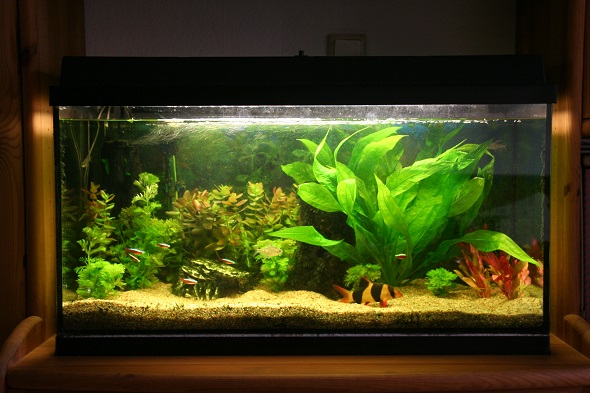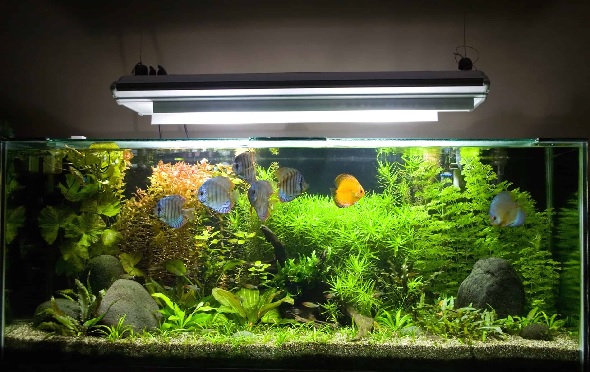Aquarium Plants And Aquarium Lighting Mini-guide
Getting aquarium plants and aquarium lighting right is as important to aquariums as water is to fish. Aquarium plants add more life to the aquarium and make it look beautiful while completing the aquarium community structure.
Benefits of Aquariums plants
Aesthetics
Live plants can greatly enhance the visual appeal of an aquarium. They add a natural and vibrant touch, making the aquarium more attractive and pleasing to the eye.
Oxygenation
Plants play a vital role in oxygenating the water. Through the process of photosynthesis, they absorb carbon dioxide and release oxygen, helping to maintain a healthy oxygen balance for fish and other organisms in the aquarium. This is especially important in densely stocked or heavily populated aquariums where oxygen levels can become depleted.
Filtration
Live plants contribute to the biological filtration of the aquarium. They absorb and utilize nutrients like nitrates, ammonia, and phosphates, which are produced by fish waste and decaying matter in the tank. By doing so, they help reduce the levels of these harmful substances, improving water quality and creating a healthier environment for the aquatic inhabitants.
Algae Control
Live plants can help control the growth of algae in the aquarium. They compete with algae for nutrients and light, effectively reducing the available resources that algae need to thrive. By maintaining a healthy balance of plants, you can minimize the occurrence of algae blooms and keep the aquarium water clear.
Natural Habitat
Live plants provide a more natural and stimulating environment for fish and other aquatic organisms. They offer hiding places, resting spots, and grazing areas, allowing the inhabitants to exhibit their natural behaviors and feel more secure in the tank. This can help reduce stress and promote overall well-being.
Breeding and Fry Survival
Some species of fish lay eggs or give birth to live young in the presence of plants. The plants provide shelter and protection for the eggs or fry, increasing their chances of survival.
When choosing plants for an aquarium, it’s important to consider factors such as the lighting and nutrient requirements of the plants, compatibility with the fish species, and the overall tank setup. It’s also important to maintain the plants properly by providing adequate lighting, nutrients, and carbon dioxide supplementation if necessary.
How to set up Aquarium plants
The most important thing to bear in mind with plants is to form an attractive background, leaving ample space so the fish can swim undisturbed and be seen. The tall, grassy type is best planted at intervals in rows, while the feathery ones look better when they are bunched into small clumps, which makes them appear like branching bushes.
When planting rooted plants, hold the tips of the bunch of roots between the thumb and second finger and rest them on the sand. Now with the first finger push the upper part of the roots (where they join the stem) about 2cm into the sand. Without moving this finger scrape with the thumb and second finger some sand over any uncovered portion of the root.
When putting rootless plants in bunches, the method explained above is repeated, but this time the lower ends of the stems are placed together and treated exactly as if they were roots.
It is important that the water surface should be right up to the lower edge of the top angle iron of the tank so that looking from the front the water surface can not be seen and the viewer gets the impression that there is no water in the aquarium.
If the level is allowed to fall below the top angle iron the tank looks like a container holding water.
Benefits of Aquariums lighting
Visibility
Adequate lighting allows you to see and observe the fish, plants, and other inhabitants of the aquarium more clearly. It enhances the overall aesthetic appeal of the aquarium and allows you to enjoy the beauty of the underwater world.
Photosynthesis
If you have live plants in your aquarium, they require light for photosynthesis, the process by which they convert light energy into chemical energy to fuel their growth. Plants use light as their primary source of energy, and without sufficient light, they may struggle to survive or grow properly.
Biological Rhythms
Many aquatic organisms, including fish, have internal biological clocks that regulate their behavior, feeding patterns, and reproductive cycles. Lighting plays a crucial role in maintaining these rhythms. A consistent day-night lighting cycle helps fish and other organisms establish regular behavior patterns and promotes their overall well-being.
Vitamin D synthesis
Some fish and invertebrates, particularly those that come from sunlit habitats, require exposure to certain wavelengths of light to synthesize vitamin D. Vitamin D is important for the absorption of calcium and plays a vital role in the overall health and development of these organisms.
Display and Color Enhancement
Proper lighting can enhance the colors and patterns of the fish and other aquatic life in the aquarium, making them more vibrant and visually appealing. This can greatly enhance the viewing experience and make the aquarium more enjoyable to observe.
When setting up lighting for an aquarium, it is important to consider the specific needs of the organisms within it.
Different types of aquariums, such as freshwater or saltwater. With the types of plants and animals you have will influence the type and intensity of lighting required.
We recommend researching the lighting requirements of your specific aquarium setup or consulting with experts in the field for guidance.
How to set up Aquarium lights
Setting up aquarium lighting properly depends greatly on whether you intend to successfully grow plants or not. Lack of light causes colorful fish to fade and clench-reds to pink, green to white. The two main methods of lighting aquariums are by the INCANDESCENT and fluorescent.
The total amount of light required is a matter of trial and error. Too much light will turn the water green; too little will stunt plant growth.
Aquarium lighting can be natural or artificial or a combination of both. The best position is near a north-facing window. This should provide the ideal amount of indirect light which can be supplemented by artificial light.
The lighting should be housed in wood constructed stylishly with the furniture and placed above the tank. If there is no natural daylight, the lights should be left on for approximately eight hours per day.
If the water turns green, you cut down on the amount and time you are using the light. The best light for showing off an aquarium comes from behind. Remember fish need as much care as your family dog does.



